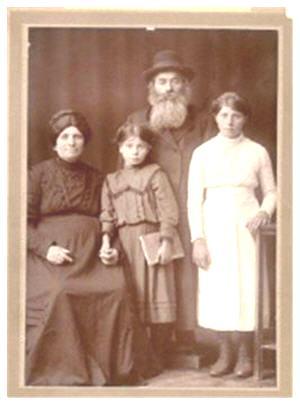Great article. My journey into my family’s history and genealogy began about 10 years ago when I helped my aunt empty my grandparents’s home and then again a few years later when we cleaned out the in-law’s house.My grandfather apparently NEVER threw anything away. Unfortunately , he also didn’t believe in organization! My aunt was going to trash it all, but I saw pictures and papers and something in me went nuts.I returned home with the entire back seat, passenger seat and trunk full of treasures. It took almost a year to clean off the coal dust of eastern Pennsylvania, and I was so thankful that state didn’t suffer the humidity we can have in the south; otherwise, I might have been facing a mounds of mildewed papers. As it was, many pictures were faded and papers were close to completely crumbling. My grandfather must have been some sort of record-keeper or business broker as I found all kinds of records, receipts, etc for families that, as far as I can tell, are totally unrelated. Through searching I’ve been able to find those families and pass the histories on to them, a wonderful feeling. The real downside of all those treasures were so many pictures will have the people remain unidentified because they were unmarked. In this digital age, it’s a necessity to make sure we name each of our digital images with a date, location, and, if needed, names of each person in the photo. I’ve also scanned every single piece of paper so I have a backup in case, heaven forbid, the originals are destroyed or lost. Future generations will enjoy our work to make sure all our family histories are identified so their places in our trees is assured.
Family Treasures: Uncover the past
- By Schelly



Sidney (Szaje) Fink
I spent many hours as a high school and college student in the famous lion-guarded New York Public Library, researching term papers.
On one visit, I picked up a dusty book – the title now forgotten. Out fell a postcard photo of a blue-eyed soldier. I immediately recognized him as my grandfather Sidney (Szaje) Fink as a young man, when he served in the Jewish Legion’s 39th Royal Fusiliers in Mandate Palestine, 1914-1917.
According to the card’s inscription and address, he had sent the card to his “dear sister Dora” in New York City. In the photo below, Dora is the youngest. It was taken in their town of Suchastow, Austro-Hungary (now Ukraine), c1915. By 1923, mother and daughters had joined the older children in New York, although the father had died before they immigrated.

From left: Rebecca, Dora, Moshe and Sadie Fink; Suchastow, c1915
I had not yet developed a sense of family history, just returning that which didn’t belong to me, so I replaced the card in the book and re-shelved it. Today, I realize this was misguided. An understatement.
When I got home, I told my mother who called my grandfather. Everyone asked why I hadn’t brought it home as it clearly belonged to us. Fortunately, another relative had a duplicate photo. Perhaps this incident helped point me to genealogy.
Our Brooklyn basement held all kinds of treasures stored over the years. One rainy weekend, I looked through an interesting box or two and discovered my grandparents’ ketubah (Jewish wedding contract). I ran upstairs to show my mother, then returned it to the – of course – unmarked box, as it clearly belonged to my grandparents.
By now, you have realized that I never found it again. I wish I had it today. Who was it that said, “Youth is wasted on the young,” or “Experience is something you learn after you need it” ? Was this another step along discovery road?
Perhaps the most dramatic incident concerns the 300-year-old Talalay family history brought from Mogilev, Belarus by one of the last young relatives to leave for America. I first heard about it while tracking down older relatives on that side of the family. Eventually, a small handful of people were located who had seen it and touched its pages in the 1950s.
The man who had it was living in Florida and, on occasion, had shown it to visiting family, although his own daughters had never seen it. Fortunately, some relatives who had seen it were artists, and they described in detail unusual calligraphied pages, some ancient, in various languages and scripts, large pages bound in a sort of album. Each relative repeated what the man told them, “This is 300 years of our family.”
When he died, the album disappeared, probably a result of someone cleaning up his apartment by just throwing out everything. Later, the younger daughter said she had never seen it. The elder daughter, who might have known something, had been in a nursing home for years and could not communicate.
I knew we would never be able to reconstruct it but I managed to obtain many archival documents, including hundreds of records from the National Historical Archives in Minsk, Belarus.
Over the years, various hidden treasures have come to light for other lucky families in other places,. In 2002, an 1811 letter written by Thomas Jefferson to his cabinet secretary was found in a Massachusetts attic. The secretary’s distant cousin had died in the home, necessitating a detailed estate inventory. Other documents, including the valuable letter, were located.
Here are some suggestions to keep in mind if you are ever the person responsible for clearing out the home of a relative, or if asked to help an elderly relative move to a retirement home. Checking the dusty corners of their home or apartment may unearth family treasures which otherwise may be lost forever.
Remember that individuals who suffer from senility, or Alzheimer’s, tend to hide things in improbable places. Those with ordinary “packrat” family members have the same searching job. People who grew up during the Great Depression or who were refugees or survivors of other traumatic historical events may have had the habit of hiding valuables, “just in case.” Allow sufficient time to do a proper search, or you may throw out valuable family history.
Look everywhere, behind and under things, on tops of closets and in corners.
Look for greeting cards, photographs, family documents hidden in old books or between old tablecloths in a drawer.
Anyone who has ever changed a light switch knows there is a handy-dandy little space back there that can hold jewelry.
All old handbags and briefcases should be searched.
Clothing, in closets or in drawers, could contain important items hidden in pockets or linings.
Stories abound of people hiding valuable jewelry in the linings of window curtains or the pockets of old winter coats.
Those famous shoe boxes on closet shelves are always a place to look for photographs, currency, documents.
Check in and under seat cushions and pillows of furniture – those with zippers have easily accessible hiding places.
Do look under large rugs. While the edges might have been moved for periodic cleaning, it is possible the larger rugs were not completely moved, and something is under there.
See a large pendulum clock on the wall or a Grandfather-type floor clock? Open it and look inside, lots of space for little items.
Check between mattresses and box springs, inside pillows.
Look at the backs of paintings and mirrors hanging on walls.
Old trunks and suitcases may have markings of previous travels or hold other family treasures.
Always look through old books before discarding them. Hold them upside down and fan the pages. Check front and back covers for handwritten notes. Everything and anything could have been used for a bookmark.
Religious books, such as Bibles and prayer books, could contain notes on important family happenings.
Kitchen canisters of flour or sugar might hold interesting items.
Check covered sugar bowls and teapots.
Check the freezer for valuable items hidden in containers or plastic baggies inside frozen food boxes. I once put jewelery in a frozen vegetable box in the back of my freezer because I couldn’t get to our safety deposit box one day. Yes, it was silly – thieves don’t go through your frozen green peas, or do they? – but I couldn’t just leave it around. I remembered to remove mine the next day. Your relative may have left it there years ago!
Remove drawers from dressers and turn them over to see if documents might have been attached, or items have fallen into the bottom of furniture. Check the backs of furniture.
Check jewelry box linings for items that might have been slipped inside.
Check vases. I once knew someone who threw spare change and other items into a large vase on the table in the entry of her home.
In these hi-tech days, and the increasing percentage of seniors with computer access, consider checking CD cases.
If and when you do find something, document where and how you found it. Store it properly so it doesn’t get lost again. If the items are documents and photographs, make working photocopies or photographic negatives, and store the originals in a safe place in acid-free, archival folders. “Safe place” here means a place where it can be located again. How many of us have put important items in a safe place – so safe that we never found them again?
If you have additional suggestions concerning places to look, or have made some surprising discoveries, share them below.










Robin G
January 15, 2018
My paternal uncle did genealogy on his paternal side (mostly) for more than 50 years. He often bemoaned how people promised him documents and then tossed them out of spite after a divorce or because they forgot or didn’t really care. Then when he went into a nursing home, he told his other niece to “burn everything,” saying he had done all the research and others could do their own. His sole surviving son didn’t want any of it, but offered it to me (and my uncle by then decided I was persona non grata and was NOT to get any of it!) Fortunately, my cousins felt differently and I got it all–about 500 pounds of material!! In exchange we helped him clean out his parents’ home and get it ready to sell. Since I didn’t care to research the side of my family that had told me to go to Hades, I scanned every bit of it and shared with about 25 other researchers. The original material is stored with a sister. Moral of the story is that you can’t expect others to care or save stuff for you even when they promise to. And you have to be ready to take action when you can. I was retired and had time–otherwise most of this would be lost.